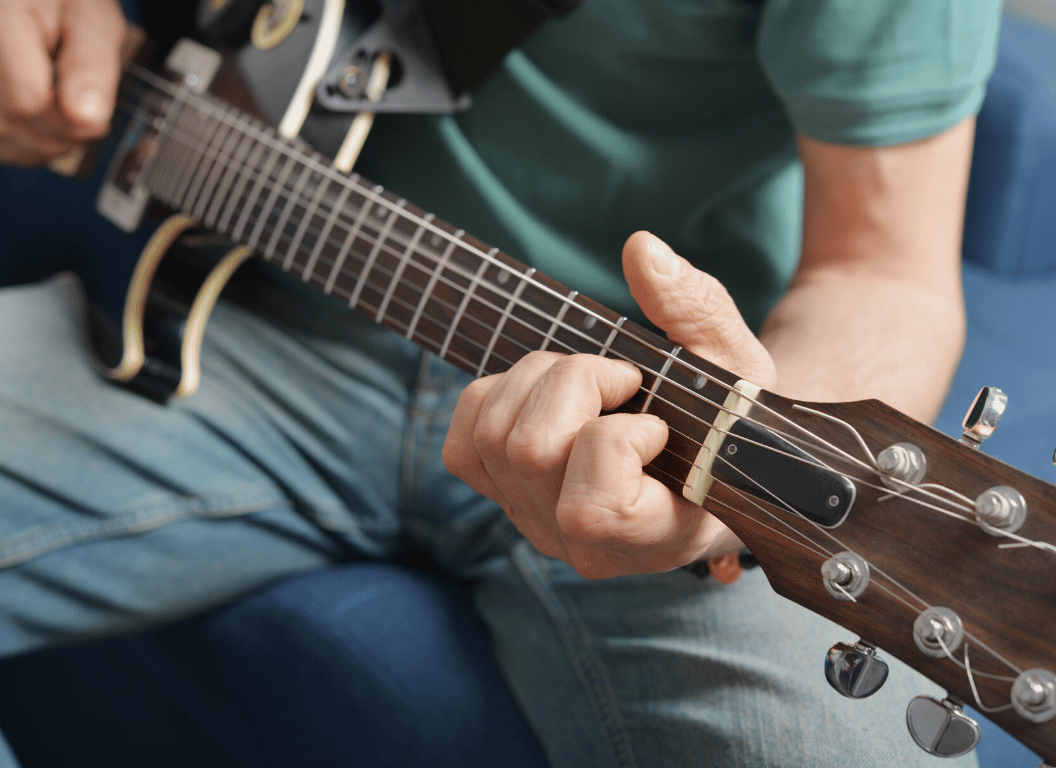How to play guitar and sing at the same time?
Every guitarist, at some point, is going to attempt to sing a song while playing guitar.
This always goes in two different ways: you’re either good or completely bad at it!
It’s very difficult to play and sing simultaneously, and it also takes a decent amount of dedication and effort to learn and be good at both of these skills.
Hence, in this post, I’m going to share some effective tips that will help you master your vocals and the ability to play your instrument altogether.
Table of Contents
- How to play guitar and sing at the same time?
- 1. Try to be relaxed and avoid any extra tension on your body and throat
- 2. Make use of a metronome to improve your timing sense
- 3. Try singing the song in a different key and within your vocal range
- 4. Take vocal lessons either from YouTube or preferably a personal instructor
- 5. Try recording yourself singing without playing the guitar
- 6. Master when to sing as you make chord changes
- 7. Hum the melody as you learn to play the song
- 8. Compose a simple song or play a simpler version
- 9. Memorize the song lyrics in your head
- 10. Practice the song several times
- 11. Re-arrange the music in such a way that suits your style and proficiency
- 12. Play and sing as slow as you can
- 13. Focus on and pay attention solely to the syllables
- 14. Get better at rhythm guitar and learn its ins and outs
- 15. Use an easy and simple strum pattern
- 16. Practice playing your guitar while having a conversation
- 17. Play your guitar like a bass
- 18. Just sing the parts where you feel comfortable
- 19. Don’t force yourself to sing just yet
- 20. Keep on trying and have fun
How to play guitar and sing at the same time?
1. Try to be relaxed and avoid any extra tension on your body and throat
This is always one of the most obvious tips that you can receive from someone, right?
Just be relaxed!? But what does that even mean? 🤦♂️
Well, in this case, I’m referring to relaxing both your throat and body.
For one, if you’re not relaxed and taking good care of your throat, you will create unnecessary vocal tension.
This can lead to a rough and harsh-sounding voice, or in severe cases it can cause a vocal cord disorder.
According to MedicalNewsToday.com, these are some things you can easily do to relax your throat:
- Bring awareness to the breath.
- Next, place a hand on the belly and relax the shoulders.
- Exhale fully, allowing the belly to relax again.
- Keep breathing this way, feeling the hand rising and falling with each breath.
- If helpful, people can make a soft “sss” sound as they exhale.
Now, when it comes to playing guitar, not being relaxed can eventually give you back and neck pain, form long-lasting bad playing habits, and in the worse case cause injuries.
An excellent way to prevent all this is to spend a few minutes before picking up the guitar taking deep breaths and doing warm-up exercises every single time.
These exercises should individually be done for both vocal and guitar playing purposes.
Other very useful guitar posture tips to prevent an injury include:
- Maintaining your back straight.
- Wearing a short guitar strap if you’re standing up.
- Keeping your wrists in a natural and relaxed position.
- Not applying extra tension on your guitar strings.
2. Make use of a metronome to improve your timing sense
Many guitarists surprisingly don’t use a metronome, and even though this doesn’t mean that they struggle to have good timing, it always definitely helps to have some sort of “tempo sense.”
Now, when you’re trying to sing, though, having a metronome beep might bother and distract you.
That’s why you can opt to have a silenced metronome that gives you visual clues or just put one at a very low volume.
Nowadays, you don’t need to spend your money on purchasing a metronome, there’re hundreds of apps online which serve that same purpose.
One that I always use is GuitarTuna:
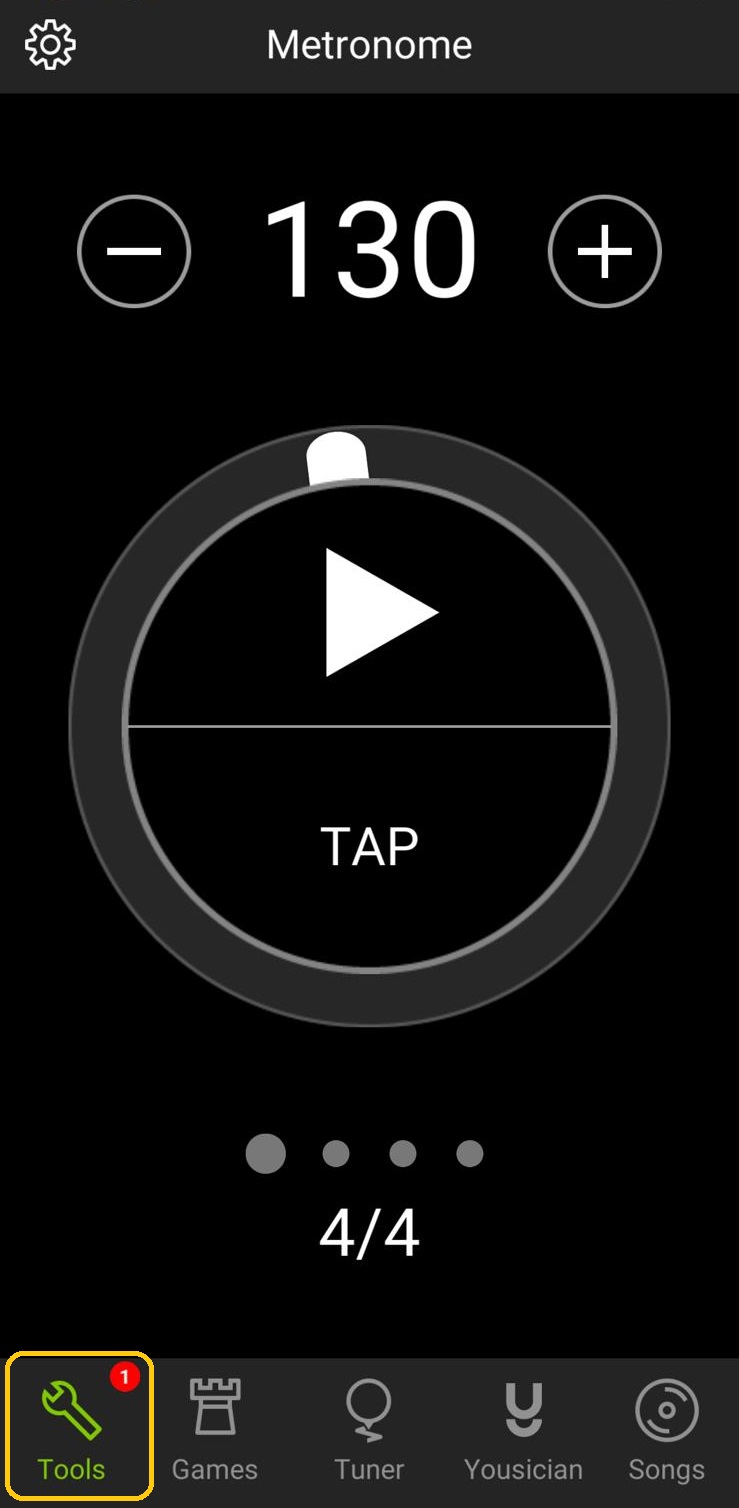
This app was primarily made to help you tune your guitar (as its name implies), but it also comes with other multiple guitar tools such as a metronome.
You can additionally just type and search for the word “metronome” on Google and a quick and very simple metronome should pop up at the top as a result.
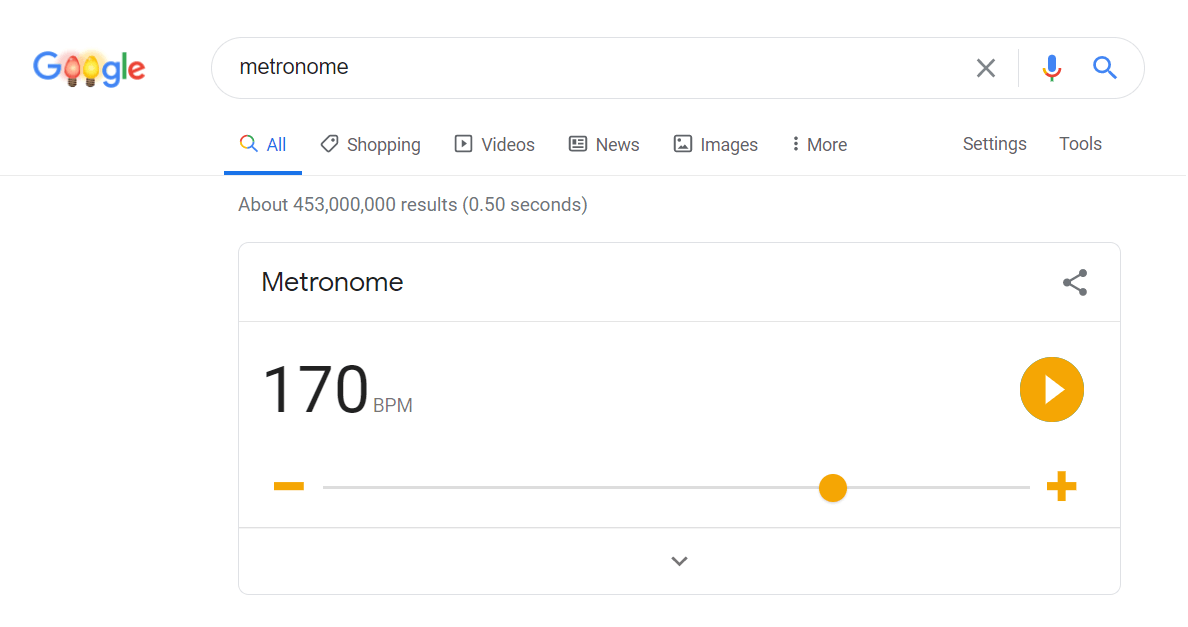
But what are some of the benefits of using a metronome:
- Allows you to track your progress.
- Helps you slow down.
- Helps you speed up.
- Develop “tempo sense.”
Here’s a video by Justin Guitar that will further help you understand how helpful a metronome could be to guitarists:
3. Try singing the song in a different key and within your vocal range
Every single one of us has a distinct voice; we’re all unique in many different ways!
Some people have a broad range and can sing in a variety of keys, but some others, though, are just more comfortable in a few specific keys or certain range.
If one key is difficult for you or it makes you feel like you’re just missing something, try changing it.
Experimenting with different keys until you find a vocal range that works for you is essential.
With a capo, you can easily move up and down the fretboard to a new position and key.
But in case you really want to study the theory behind it, or rather an interesting way of memorizing this process, then you should definitely watch this video:
While the information that he shares is all very valuable to any guitarist, it can also prove to be very overwhelming to some beginners.
If that applies to you, then ignore it completely, and just stick to using a capo for now.
This method makes singing easier because the music will be tailored to your own voice and you won’t have to work as hard to sing on pitch.
Finding your talking voice/range
Another very interesting method that will help you get comfortable is by just using your talking voice to sing the songs.
The same thing that I mentioned before about changing keys applies, but this time, you will only try to find a key that allows you to make no effort at all.
One thing to have in mind, however, is that when I say “talking voice” I don’t mean that you should start singing in a monotone way.
You will still sing songs as you normally would, but they will just be in the same range that you usually speak at.
4. Take vocal lessons either from YouTube or preferably a personal instructor
Vocal lessons may be needed for certain guitar players, especially if they have tried to sing multiple times and it just never works out for them.
Not everybody is born with the ability to sing!
But guess what? That’s perfectly okay!
With time and dedication, you could be able to, at the very least, sound decent enough that you impress your family and friends.
There are multiple resources online to help you teach yourself how to sing.
For example, Ramsey Voice Studio on YouTube:
With this video alone, he will show you about having a tall posture, breathing the right way, and doing vibrato as both males or females, but also how to go from doing singing exercises to singing actual songs, and much more.
Aside from that video, we also found another one in which he helps you find your natural singing voice.
If you have been following along until now, then you know we just talked about this earlier.
I really encourage you to watch that video entirely, since not too many people on YouTube have covered how to isolate your chest voice from your head voice, and your mixed voice.
In addition, he will also give you tips on how to find your genre and how to choose songs that fit your voice.
We tend to always compare ourselves to other people, so this is a great reminder that you shouldn’t be imitating somebody else, but rather get inspired by those who you admire.
We already have them, but we don’t have you.
If you don’t believe that you can be the best vocalist, just be confident that you can become the best version of yourself when it comes to this matter.
Now, a decent online vocal instructor will teach you the fundamentals, but it’s impossible for them to tailor their lessons to your own specific situation.
This is when finding a personal instructor, or somebody to specifically judge and teach you 1-1 is very recommended.
When you attempt to do this on your own, you are very likely to make errors and develop bad habits.
Having a teacher would come in very handy to prevent you from doing that right away.
5. Try recording yourself singing without playing the guitar
This is one of the most underrated tips when it comes to this topic and a lot of beginners never tend to do this at all.
In order to perfect your singing skills, you need to actually be able to know what exactly you’re doing right or wrong.
If you don’t have a personal instructor as we mentioned earlier, then most of the criticism will have to come from your own judgment.
Recording yourself singing without playing the guitar is a great way of doing this.

Nowadays, most of us have phones and computers, and if you’re reading this, chances are, your device has a built-in microphone.
Instead of buying a professional mic or any other recording equipment, you should make use of what you already own to record your voice.
At first, do so without playing your guitar, and then try to look for whether or not you’re singing out of tune.
You should also take note of your breathing techniques.
After you’ve corrected every small mistake possible, then start recording yourself playing and singing with your guitar.

This time, though, I would advise you to record a video instead; you can use your phone for that.
By recording a video, you will be able to know where exactly in your playing you’re generally struggling to make it work, and you can then start practicing those little sections individually.
Isn’t recording only useful for sharing with other people? You might ask!
Though recording your singing to show other individuals is extremely useful, the absolute reason why you must do it is so that you hear yourself properly.
When you record yourself and then listen to that recording, you will be hearing yourself from another person’s perspective.
If you didn’t know, when we hear ourselves, we sound quite different from what other people actually hear.
This YouTube video will help you find out how to hear yourself from another person’s perspective:
As he explains, when we cover our ears with either two books or two sheets of paper, we don’t hear the sound coming straight from our mouths.
We hear our voice being reflected across the room and affected by all possible factors instead.
6. Master when to sing as you make chord changes
You know that feeling when you’re trying to play guitar and sing at the same time, but the guitar part doesn’t follow the lyrics at all.
To put it another way, the guitar melody could just be following a certain structure while the singing part is offbeat, or vice versa.
For most beginner players, or anybody singing while playing guitar for the first time, this could be a challenge.
Now, there could potentially be two scenarios; you are either:
- Writing your own song.
- Or covering a popular song.
For scenario #1, you can just change the song and make it easier to perform, although is very unlikely that you face this problem with your own songs since you would ideally just write songs that you’re able to play.
But when it comes to scenario #2, then you have no other choice than to learn how to do it or change the way the guitar part goes a little bit.
For example, let’s take a look at the tabs for Sweet Child O’ Mine by Guns N’ Roses:
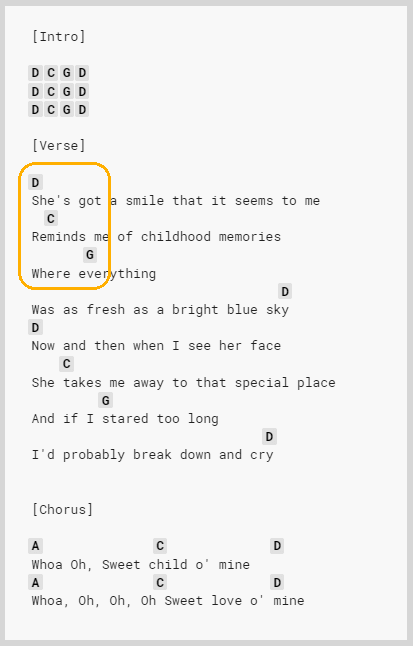
This is the perfect example of a song where the chord changes don’t follow the same pattern all the time. Sometimes they get changed in the first syllable of a word, and some others in the second syllable.
As guitar players, if we have trouble singing and don’t know when to play a certain chord while performing the lyrics, then a quick look at the song tabs in terms of each syllable can be of great help.
We can then associate each chord change with a syllable or word, hence helping us remember where exactly to do the progression and allowing us to do so smoothly.
If you are writing your own songs, you can still do this.
Just write down your lyrics on a piece of paper, or type them on your phone notes, and after that put the chords on top of the exact syllable or word that they go on.
Coordinating your guitar and voice doesn’t always have to be difficult, with practice, you can get to a point where doing all this would be unnecessary and you would just remember it in your head.
7. Hum the melody as you learn to play the song
Another amazing piece of advice that you can start applying today is to hum the melody if you’re struggling to keep a good timing when singing the lyrics.
Humming a song turns out to be easier than actually singing it, so this could be a great way of slowly getting comfortable with your singing and playing coordination.
According to Oxford Languages, to hum is to:
Make a low, steady continuous sound.
In other words, when you hum, you are essentially making a sound by producing a wordless tone with your mouth closed, forcing the sound to emerge from the nose.
This sound could often be produced in such a way that it makes a melody.
You should do this in any part of a song that you are having a hard time performing.
Then slowly as you progress and get comfortable playing the guitar while humming the song, you can start alternating between humming and actually singing the lyrics.
Here is a great YouTube video to help you hum in the best and most beneficial way possible for your voice:
On another note, if you find humming to be a little bit uncomfortable or still hard to do, there are a few other alternatives that you can keep in mind.
You can either whistle the song’s lyrics, or just sing the songs in your head.
Doing all these three methods is essential since they won’t require you to pay attention to the actual voice techniques that you’re using.
This ultimately lets you concentrate on developing your voice/guitar coordination first.
8. Compose a simple song or play a simpler version
Another way of learning to sing and play the guitar at the same time is to compose something basic or choose simple songs to play or cover.
Sometimes we struggle to sing and play altogether because we’re essentially not used to doing so.
The majority of most popular rock songs use only 3 chords.
And sometimes, some artists and bands go as far as to releasing one-chord songs. These songs are just like their name suggests, one chord being played throughout the entire song.
Here are 10 one-chord songs on guitar that you might be interested in learning:
Why even bother learning such simple songs?
Just because it makes no sense to attempt to sing a hard song if you have never learned to sing a straightforward song first.
Make it your priority to start with easy songs and slowly start adding more chords, progressions, and melodies to it to make it complex.
A song with two or three chords is perfect, to begin with.
In my personal experience, the first two chords that I remembered playing effortlessly were Am and C.
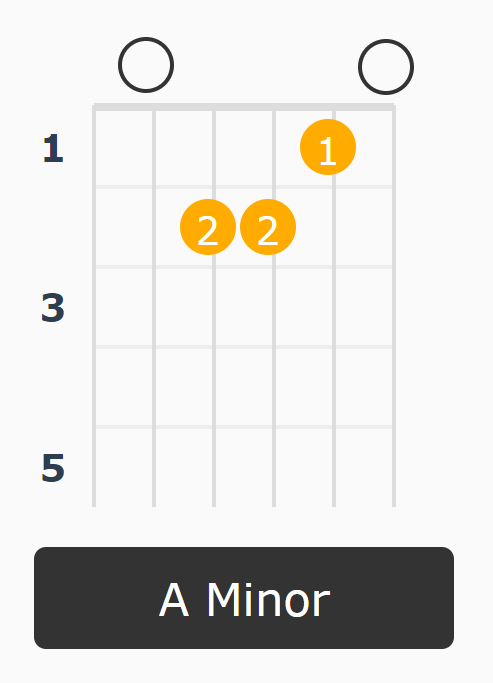
When playing an A Minor chord, you will have:
- Index Finger: first fret, second string.
- Ring finger: second fret, fourth string.
- Middle finger: second fret, third string.
This chord structure is just one change away from being a C Major chord, you just need to move your ring finger to the third fret, fifth string.
Leaving you with this chord pattern:
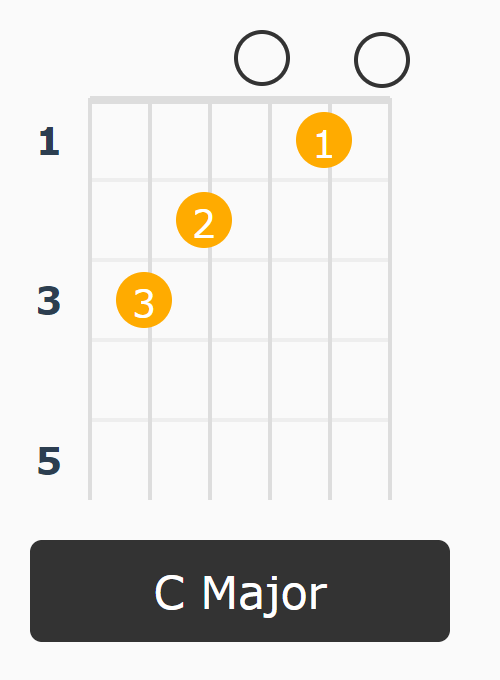
As you can see, by learning either of these two chords, you will be more than halfway to learning the other chord.
In case you find yourself struggling to play this progression, this YouTube video should be of great help.
There is a wide variety of songs that are both simple to perform and sing with this chord progression.
Aside from that, you can choose to compose your own lyrics using these two chords.
Since it’s very easy to play them, once you develop the right muscle memory, you can just focus on your vocals and having the right timing at all times.
9. Memorize the song lyrics in your head
Before you perform a song, take the time to learn the lyrics up to the point where you can’t get them wrong.
If you can’t remember them, write them down on a piece of paper but still make the attempt to sing them without having to look at the paper.
Just like how we said to play the guitar part repeatedly in order to develop muscle memory, singing the song many times will have a similar effect.
By doing either or, you will subconsciously have to concentrate less while singing and playing guitar simultaneously.
You can also divide the song into verses and memorize them one by one.
Ultimately, the goal is to get as comfortable as possible so that instead of having to think about it, everything would just come naturally to you.
10. Practice the song several times
There is no way of learning to play and sing until you take the songs and practice them constantly.
Even though this is as obvious as it gets, you would be surprised at how many people underestimate the power of practicing over and over.
Take yourself as an example, if you found this page through doing a search online, what made you search whatever term you searched in the first place?
Maybe the answer to whatever issue you think you’re having with your guitar right now is simply to practice more.
And if you’re doing so already, then being a bit more patient is the next evident thing to do.
“The only thing that’s holding you back, is the way you’re thinking.” ~ Steve Vai
Use that quote as a way of reminding yourself that you are capable of anything that you set your mind and efforts into.
If you devote enough time to learning the tune, you WILL be able to achieve whatever goal you have.
But, how much is enough?
Well, with each session, I would say to try to devote at least 15-30 minutes to singing and playing guitar together, aside from your regular guitar practice schedule.
11. Re-arrange the music in such a way that suits your style and proficiency
In certain situations, you might need to change the song to fit your personal preferences.
This is in case you’re doing a cover of a popular song, or something similar to that.
According to Wikipedia:
In popular music, a cover version, remake, cover song, revival, or simply cover, is a new performance or recording by someone other than the original artist or composer of a song.
To put it another way, you will have full control over what you want to play and sing in any part of the new cover song.
You may want to delete or add components or simply borrow melodies from older songs.
The lyrics and rhythms are almost every time changed to match the player’s personal style.
When it comes to genres, there is certainly just about any genre nowadays, so it’s just a matter of choosing one that you are comfortable with.

“Music Genres” | Image Source: Poster Foundry on Amazon
Take a pop song and make it reggae, for instance. Or take a hip-hop track and turn it into a blues song; the possibilities are endless.
In some cases, you might also need to adjust the key of the song to match your own vocal range, just how we mentioned earlier in this article.
Changing the song will help to add diversity, dynamics, and uniqueness, and will definitely allow you to play the song in any way that you find effortless.
12. Play and sing as slow as you can
When playing out and singing a new song, you should not begin at full pace, especially if you’re a beginner in any of these skills.
Slow down so that you can play all of the guitar parts without making any mistakes, and also allow your voice to slowly and naturally fit in.
If you remember what we talked about before, you should know that having a metronome has many advantages and benefits in a situation like this.
Just like metronomes are very useful to increase your guitar playing speed, they can also allow you to efficiently slow down to learn a certain skill.
As you get better, then gradually accelerate the tempo until you hit the song’s original pace.
This YouTube video will help you further understand the advantages of playing and starting slowly:
Some benefits of playing guitar slowly are that it will:
- Allow yourself to build muscle memory.
- Gain speed while maintaining good form.
Now, not only does playing slow mean to literally play slow but you can also use simpler strumming patterns at this point (more on this below).
13. Focus on and pay attention solely to the syllables
Syllables are the actual sounds that makeup words phonetically, and it’s crucial to understand when each phrase is spoken in reference to the strum or chord being played.
Learning to play and sing at the same time is all about understanding when specific syllables of a phrase are sung.
This will then help you perform the right note or chord concurrently at the exact time that they should be played.
All this entire process involves listening to the music many times and paying attention to each word and each syllable in the word.
Of course, it all depends on whether you’re singing and playing your own song, or covering a popular track.
When covering a popular track, you can easily do a Google search for the song’s tab, and all the work will have already been done for you.
Let’s take a look at “Aint No Sunshine” by Bill Withers via Ultimate Guitar, for example:
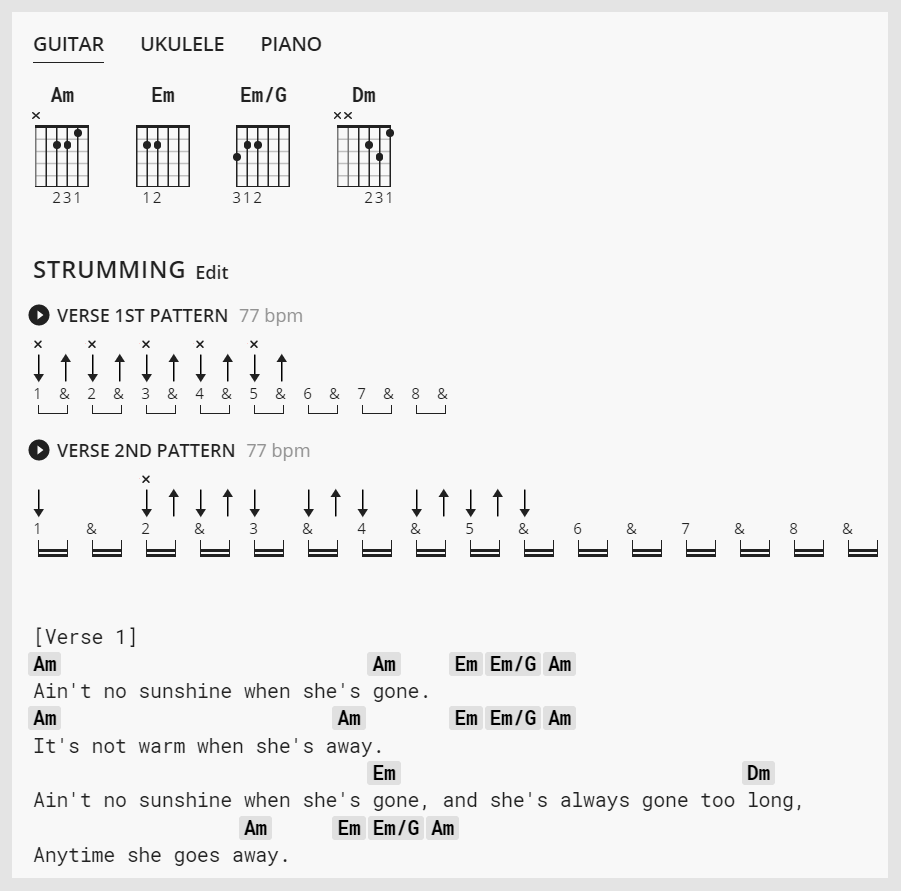
You can see how the platform gives you all the chord charts, strumming patterns, and the exact syllables where each chord gets changed on.
Again, in case you’re attempting to sing and play your very own song, you should do something similar to that.
14. Get better at rhythm guitar and learn its ins and outs
To be able to sing and play guitar at a decent level, you must be able to be very comfortable at rhythm guitar.
This means being good at strumming your guitar, fingerpicking, and even doing some licks here and there.
You must also be proficient at playing all sorts of chord progressions and finding ways of playing similar melodies on different fretboard positions (more on this below).
You can also try straightforward styles such as blues, which act as the basis for most songs and usually consist of about three chords with the same pattern throughout the track.
I would recommend you check out twelve-bar blues songs, which:
Have a distinctive form in lyrics, phrases, chord structure, and duration. And they all in its basic form, are predominantly based on the I, IV, and V chords of a key.
Aside from that, make sure to break down the song that you’re trying to play into sections before adding the vocals.
Then after that, study and master the guitar parts in each one of those sections.
But be careful, though, this all depends on your specific goals and whether or not you’re trying to sing somebody else’s song or your own.
Writing down the lyrics and placing the chords right on top of the exact syllable that they are supposed to be changed on also helps you visualize this entire process, just like we said in the previous point.
15. Use an easy and simple strum pattern
Another very helpful thing to do is to just use very simple strumming patterns whenever you’re playing chords.
In my case, one of the things that I always struggled with, was whenever a song required me to do a very odd chord change or just something that I never developed the muscle memory for.
Such cases inevitably made me opt for different ways and techniques that were easier for me at that time.
For example, a song that I always wanted to play and sing was Dust In The Wind by Kansas.
If you’ve heard that song before, then you would agree with me that for an absolute beginner, the fingerpicking patterns used on that song are difficult.
For some reason, strumming the chords was easier for me at that time, so that’s what I did.
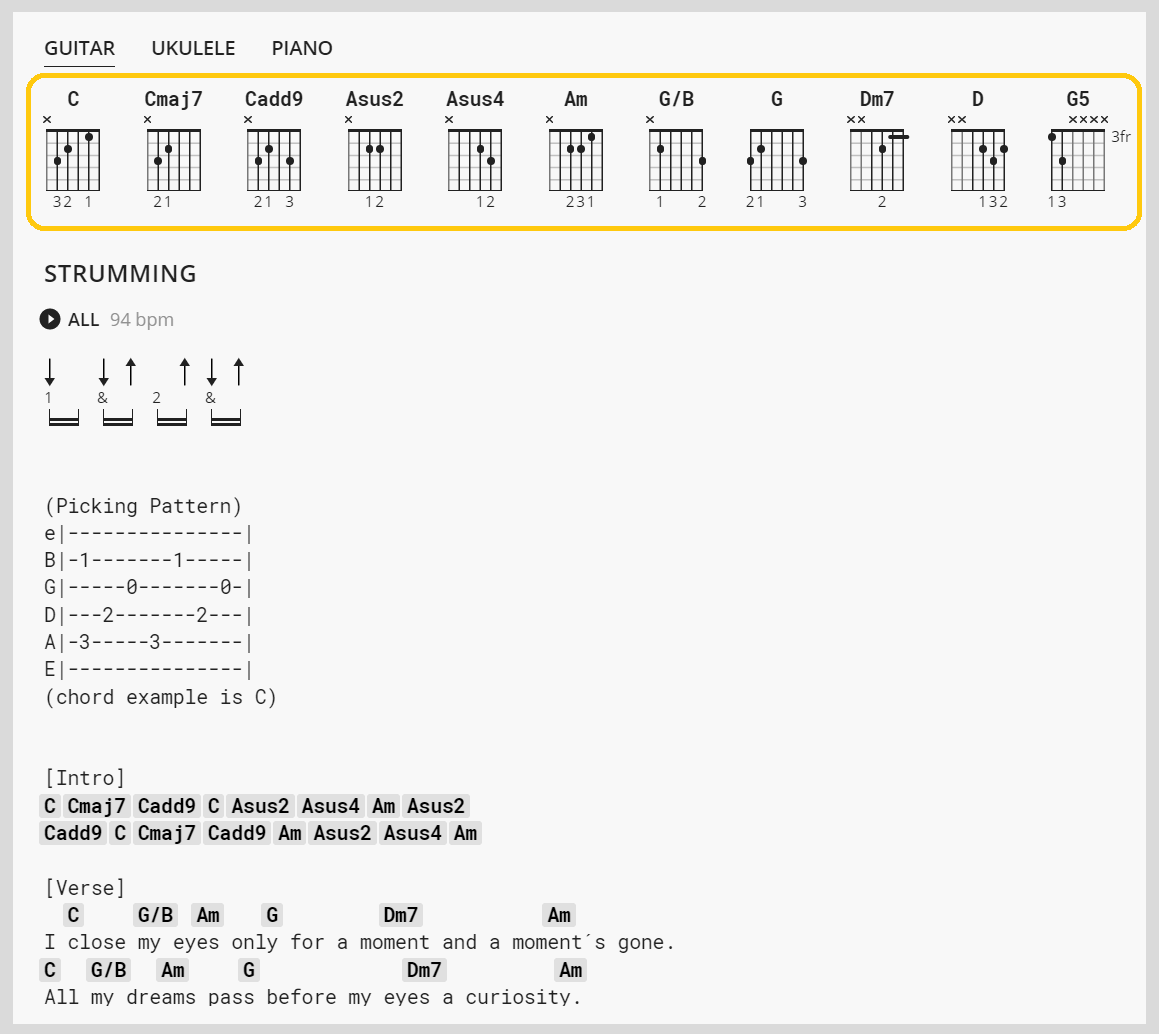
And just like that, I was playing a song that I always loved and enjoyed.
With time and a lot of patience, I learned to fingerpick.
Up to the point where the first time that I attempted to actually play the song using the original arrangement, I was able to instantly do it.
16. Practice playing your guitar while having a conversation
Talking during a song is not only helpful when building your ability to sing while playing the guitar.
Sometimes, as performers, we might be obligated to do a quick introduction to a certain track.
Oftentimes, you will see famous musicians talking before starting the actual song. but if they plan on sharing how and why the song was written, then they usually do it with a soft guitar playing in the background.
Someone that does this all the time is Dave Grohl of Foo Fighters!
Now, I know that doing this by yourself in your room might be a little bit awkward.
And even more, if you have any family member that can hear you from far away.
If you don’t want to sound silly, then take your guitar outside of your room, or wherever you practice.
And then just go talk to your family or simply call a friend on the phone while playing your instrument softly.
By doing this, you will train your brain to be familiar with doing multiple things at the same time, and just like we’ve said multiple times, you will also develop muscle memory through constant repetition.
Transitioning from talking to singing will be much easier if you’ve been doing it for a decent amount of time.
17. Play your guitar like a bass
When all else fails, then playing your guitar like a bass is another great option that you could consider.
By saying “play your guitar like a bass,” what I really mean is playing only one note at a time, and keeping things as simple as possible.
For example, when playing a chord, you could just play the root note of that chord.
Later, if you want to make it either a minor or major chord, you can choose to add the 3rd in the appropriate scale.
According to Fender.com:
The difference between a major and minor chord comes down to one, simple change: the 3rd in a scale. A major chord contains the 1st, 3rd, and 5th degrees of the major scale. A minor chord contains the 1st, flattened 3rd, and 5th degrees of the major scale of that note.
To help you visualize this, let’s take a look at a B minor chord chart:
Note: The numbers represent the fret position.
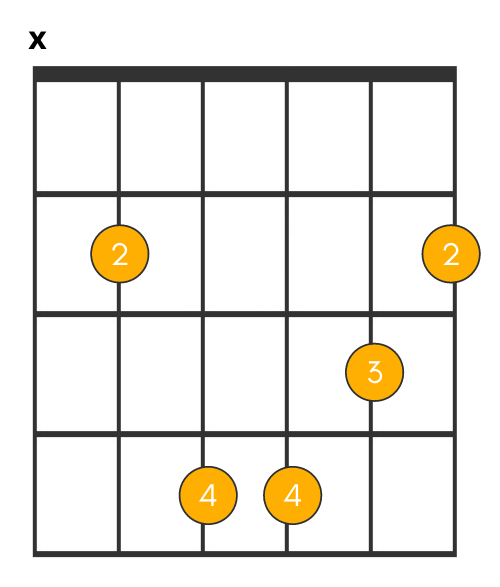
As you can see, there is a barre chord in the second fret. Now let’s say that you’re not too comfortable playing this chord pattern yet.
What can you do?
Well, you can either choose not to play the song at all or find an easier way of playing it.
For example, that same B minor chord could also be played by doing something like this:
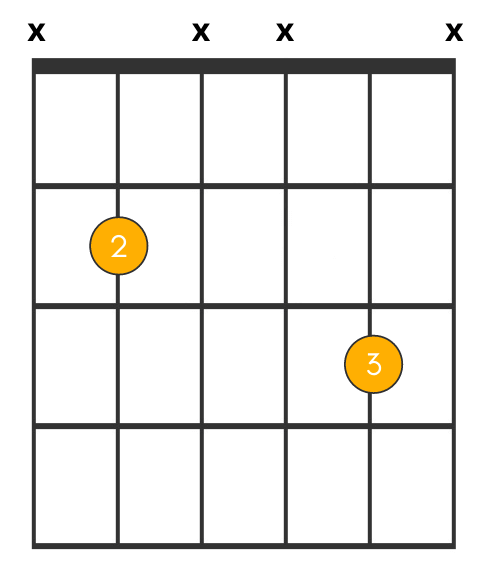
You will be playing the root note with your index (B), and then the 3rd in the scale (D) with your ring finger, which ultimately makes it a minor chord.
To make this chord pattern major, then you would just change your ring finger position to a D# in the fourth fret.
Which would end up looking something like this:
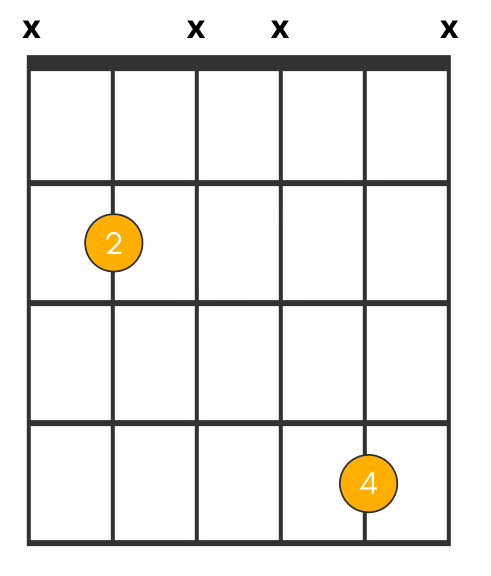
You will see this last chord pattern being used extensively in genres such as pop, for example, in Love Yourself by Justin Bieber.
Now, this can be bad advice to some extent, since it doesn’t encourage you to learn proper chord patterns from the start, and playing only one note per chord is rather a boring thing to do.
But, as I said before, if you find it necessary, then, by all means, do it.
18. Just sing the parts where you feel comfortable
This is very straightforward to explain.
If you’re covering a song and you don’t feel like you can sing and play a certain part, then don’t do it.
Just jump in any part where it makes sense to you, or where you feel like you genuinely could sing and play it all at once.
Sometimes, the vocals and the guitar can be in syncopation.
Syncopation is a musical term meaning a variety of rhythms played together to make a piece of music, making part or all of a tune or piece of music off-beat.
To put it another way, the guitar could be following the beat, while the vocals are doing the complete opposite.
More simply, syncopation is “a disturbance or interruption of the regular flow of rhythm.”
If a certain song has a lot of syncopation happening throughout all parts, then it might be difficult for the regular player to sing and play.
19. Don’t force yourself to sing just yet
In other cases, it’s better to just not force yourself to sing just yet.
I’m not sure at what level exactly you are when it comes to both singing and playing the guitar.
The truth is, that for some people, the time to do so is not really when we think it is.
You might be better off just focusing on one thing right now, and then in a few months, getting back into learning to do both again.
At the very least, if you don’t want to completely stop right now, then I would recommend you set aside a few minutes every day.
Ultimately, what I’m trying to help you avoid is, not making any progress in either playing guitar or singing, and this being the cause of your potential lack of motivation.
20. Keep on trying and have fun
At the end of the day, it should all be about having fun.
Would this article even be a guitar tutorial post without including this at the end? No! 😆
If you see that you’re not making any progress, then keep on trying and enjoy your own journey.
Also make sure to not try to copy other people, since it will prevent you from really developing your own style.
While it’s okay to get inspired, don’t try to base your entire music around somebody else, just be you!
And lastly, here’s another great resource that you can use to further your knowledge on this topic:
Something that I really loved about this video is that he shares how exactly he learned to play and sing simultaneously.
He says that when it comes to his personal experience, noticing where chords would change in a song even before trying to play that same song would later help him play much better.
By doing that, he was developing his timing awareness way before he attempted to sing and play for the first time.

Dad, husband, son, and guitarist. I’ve been playing guitar for 20 years. Passion for writing, painting, and photography. I love exploring nature, and spending time with my family. Currently have a Gretsch G5220 Electric Guitar as my main instrument.



